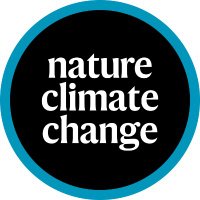
NatureClimate
@natureclimate
A monthly journal covering the science of climate change, its impacts and wider implications for the economy, society and policy. Tweets by Bronwyn
ID: 163844242
http://www.nature.com/natureclimatechange 07-07-2010 12:26:20
9,9K Tweet
54,54K Takipçi
209 Takip Edilen

Whale sharks may be up to 15,000 times more likely to collide with a shipping vessel at the end of the century, under a high-emissions scenario, according to a study in NatureClimate. go.nature.com/3zKOOCr


Climate change may have increased the proportion of wildfire smoke-related human deaths by about tenfold between the 1960s and 2010s, suggests a paper in NatureClimate. go.nature.com/3C27M86


A study in NatureClimate shows that climate change is increasing burned areas in most regions, particularly during periods of peak fire activity. Changes in population and land use are mitigating some of the effects of climate change. go.nature.com/3YyVGwk


Findings, published in NatureClimate , showed that the amount of burned area is, on average, around 16% greater than it would be if the world’s climate was similar to pre-industrial times. See the full paper: nature.com/articles/s4155…

Increasing land drying & drought will threaten water-sensitive species such as frogs 🐸. We examine the potential exposure risk under different warming scenarios | nature.com/articles/s4155… | NatureClimate


Our recent piece at NatureClimate (w/Tim Wappenhans, Heike Klüver & Lukas F. Stoetzer) is summarised in this @LSEEuropp blog post!

New paper NatureClimate finds humid heat during the 2024 Hajj pilgrimage neared human tolerance limits. Analysis (by Minderoo Foundation, including CCRC’s Steven Sherwood Steven Sherwood and Katrin Meissner Katrin Meissner) warns that further warming would rapidly threaten more people.

WCS team members contributed to an insightful article in NatureClimate on human physiological limits to critical thresholds of humid heat focusing the mass mortality event at 2024 Hajj pilgrimage. nature.com/articles/s4155… Fahad Saeed Mariam S. Khan Anwar Sadad Khan Atta Ullah

My PhD student Ashley Dancer and I wrote a commentary in NatureClimate on the nice new paper by van de Ven et al., incl. Ida Sognnæs & Glen Peters, which documents how the IPCC scenarios have changed their assumptions over time. 1/🧵 nature.com/articles/s4155…

🚨 New Article: Farhan Akhtar and I reflect on the first global stocktake under the Paris Agreement, highlighting key findings and innovations. NatureClimate UN Climate Change @iGST ClimateWorks Foundation @IPCCCH Read full paper nature.com/articles/s4155… summary thread here bsky.app/profile/harald…


Great to see Nature Reviews Clean Technology first issue online! Go have a read

Welcome Nature Reviews Biodiversity - great first issue

How the carbon stocks of the Arctic–Boreal Zone change with warming is not well understood. A study in NatureClimate shows that wildfires and large regional differences in net carbon fluxes offset the overall increasing CO2 uptake. go.nature.com/3CjkRL0


Ice ridges in Arctic sea ice are becoming smaller and less common, according to new research in NatureClimate. Comments from Evgenii Salganik and others; story by @nathanielscharp. eos.org/articles/arcti…

In NatureClimate, we show that a year above 1.5 °C signals that Earth is most probably within the 20-year period that will reach the Paris Agreement limit. nature.com/articles/s4155…

Two papers in NatureClimate suggest that exceeding 1.5 °C in 2024 may indicate that we have entered a multi-decadal period of 1.5 °C average global warming and that stringent climate mitigation efforts are needed to keep the Paris Agreement goals within reach.


A study in NatureClimate finds that the urban heat island effect has net positive impact by reducing more cold-related mortality and highlights the necessity of place-based adaptive cooling strategies. go.nature.com/3Gkq7j6

